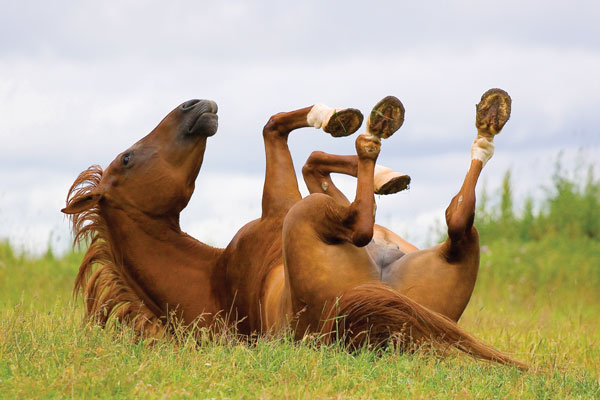
Colic surgery. It’s invasive, astronomically expensive, and there’s no guarantee it will be successful. If your horse does make it through the colic surgery, recovery is long, arduous and time-consuming. And when he’s recovered, he’ll always be prone to future colic.
Or maybe not.
Lifting the Veil of Fear
Depending on the type of colic your horse has and how quickly it’s treated, he’ll have up to a 90 percent chance of coming through surgery and healing uneventfully.
While colic surgery is a major decision, continual advances in techniques, medications and follow-up treatment mean that colic surgery today can be a life-saving procedure with a good recovery rate and a return to full work after healing.
As with any major decision related to your horse’s care, the more knowledge you have before the stress and drama of an emergency situation, the better.
Common Types of Colic
Some forms of colic that require surgery are more favorable than others in terms of prognosis and recovery.
“These include large colon displacements, impactions and enteroliths [stones], which typically yield upwards of 90 percent success rates for hospital discharge,” says Wade Walker, DVM, Dipl. ACVS-LA. Walker is with Alamo Pintado Equine Medical Center in Los Olivos, Calif., a regional equine treatment center that performs over 100 colic surgeries per year.
Colics with less favorable prognoses include those in which the blood supply to the small intestine or large colon is compromised and the surrounding tissue is damaged.
“For example, a strangulating lipoma or a large colon volvulus [twist] are more severe cases,” he explains. “These require more serious intervention, and recovery from surgery may be more complicated.”
Pre-Op for Horse Colic Surgery
When your horse arrives at the emergency clinic, testing will begin to determine the degree of compromise.
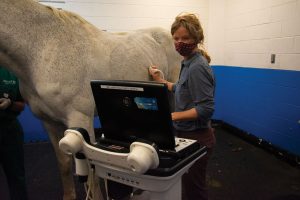
“Abdominal ultrasound, assessment of the horse’s vital signs and a physical exam begin our decision-making process,” says Walker.
“We’ll also perform several diagnostic tests, including lab work on blood to evaluate hydration status, white blood cell count, organ function, systemic infection and other criteria. Lab work can also be run on abdominal fluid, if warranted, to gather additional information,” says Shannon Murray, DVM, M.S., Dipl. ACVS, with Littleton Equine Medical Center in Littleton, Colo. The clinic, founded in 1950, is a recognized referral center for the Rocky Mountain region.
“We’re continually monitoring the horse’s pain level,” she adds. “In some cases, additional medical treatment in the clinic setting can resolve the colic without surgery. Severe pain can mean surgery is the next step.”
Based on initial prognosis and your agreement to proceed, your horse will be prepped for surgery.
“While surgery can be a big decision for the owner to make, once we open the abdominal wall, we will have a better idea of what we are dealing with,” says Murray. “Before that, all of the diagnostics help guide us in [determining] the type of colic your horse is experiencing, but surgery provides a clear picture of the situation.”
In the O.R.
“I always tell clients that there are many steps and evaluation points during surgery,” says Murray. “We keep in touch with the owner, and at any time, we can change course or stop the surgery based on what we find. The severity, prognosis and financial considerations that increase with a more complicated surgery may mean that we choose a different outcome.”
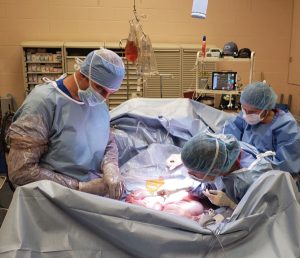
Each colic surgery is different, depending on the underlying cause and disease process.
“In general, for displacements, the abdominal contents are removed and replaced in their correct position,” says Walker. “In the case of feed impactions, the bowel is opened and the feed is surgically massaged out in order to empty the bowel.”
If the bowel has lost its blood supply, the devitalized section must be removed, and the healthy components are stitched back together as well as possible.
“In the worst cases, we see that the intestine has ruptured, causing systemic infection,” says Murray. “Sadly, this means euthanasia is needed.”
Colic SymptomsIf your horse hasn’t had a colic episode before, you may not know what the symptoms look like, which can range from subtle to obvious: ◆ being quieter than normal |
Post-Op and Recovery
When surgery is complete, a typical recovery and rehab schedule for your horse may look as follows.
◆ First week: Following surgery, the horse will remain at the clinic on stall rest, with frequent monitoring and medications administered as needed.
◆ First month: Stall rest with hand walking for 10-15 minutes, two to four times per day. Hand grazing is ideal.
◆ Second month: Stall rest with access to a small pen or paddock with daily hand walking.
◆ Third month: Stall rest with access to a larger turnout area or small pasture.
◆ Fourth month: Return to riding. For some horse owners, the rehab requirements may be a bigger decision point of colic surgery than the financial aspects.
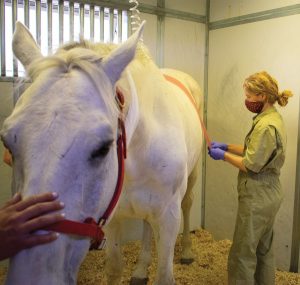
“There is no guilt or shame in deciding against colic surgery, knowing what the after-care will require and whether you have the means to provide that, or whether your horse’s behavior is conducive to the required recovery and rehab,” says Murray.
If the owner isn’t able to provide appropriate physical rehab but has the financial means, the horse can be boarded temporarily at a rehab facility. Some vet clinics offer a reduced rate for longer-term care if the horse will be staying during the recovery period.
In general, most horses return to their normal diet following surgery. Some horses, such as older horses with tooth loss or poor chewing ability, may be changed to a wet or soaked diet.
Cost and Insurance
There’s no guarantee of success with colic surgery, but if your horse is a good candidate and the prognosis is good, your decision may come down to the financial concerns.
Colic surgery costs vary greatly based on size of the horse, the complexity of the surgery, complications and more. A general ballpark is $8,000 to $15,000.
For some horse owners, the cost is a non-issue, while for others, cost may be the deciding factor. If agreeing to colic surgery means your financial stability is threatened, think hard about the decision.
“Owners should never feel bad for the decision they need to make,” says Murray. “Know what you can afford before you’re faced with making a decision in a very stressful time.”
Several supplement companies offer free colic surgery reimbursement up to $10,000 if you use their supplements and provide your horse with several wellness protocols, including an annual physical exam plus deworming, dental care and vaccination programs.
“Colic insurance can be a blessing in these cases, and potentially remove the economic factors that affect decision-making,” says Walker.
Another option to help with expenses is the CareCredit program. If medical bills put on this credit card are paid in full within a certain amount of time, no interest is charged.
Of course, there is also traditional equine insurance, which covers mortality and high medical expenses, most commonly colic surgery. Know your coverage amount, any exclusions, whether it only pays out if surgery is attempted, and any other details before signing on for a monthly or yearly premium.
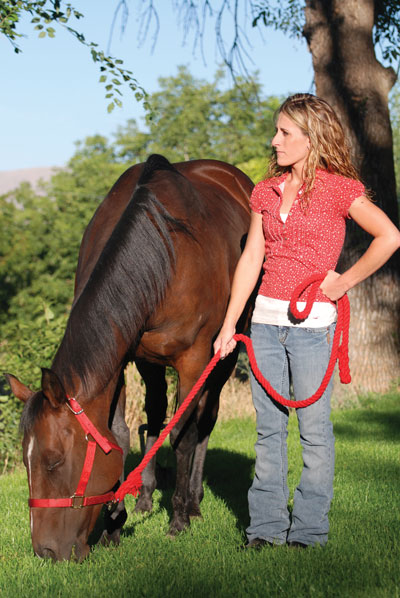
Next Steps
Facing a potential colic surgery may be one of the most stressful events a horse owner can ever experience. But you’re not alone.
“Your veterinarian is there to guide you through the process and apply as much evidence-based information as possible,” says Walker. “Efficient and informed decision-making often yields the best outcomes.”
Finally, have a plan for transporting your horse to the emergency clinic. If you don’t have your own trailer, line up friends, family, or a local transport provider you can call in an emergency.
Before you’re ever faced with a colic that may need surgery, take some time to pre-plan and consider whether colic surgery may be an option for your horse.
Remember that whatever your decision is, your veterinarian understands and is ready to support you.
Is Your Horse a Good Candidate for Surgery?◆ One of the best indicators of success in treating colic is time—the sooner the horse begins receiving treatment, the better the prognosis. Several types of colic can be resolved with a farm call and medications. ◆ Your horse’s age is not necessarily a factor. Several studies have shown that older or geriatric horses have similar prognoses and recoveries as younger horses. ◆ Does your horse have pre-existing conditions or co-morbidities? Cushing’s disease, active laminitis, arthritis, and other conditions may make recovery more challenging. ◆ As with age, your horse’s personality is not necessarily a factor. While naturally quiet horses may deal easier with the stall rest needed to recover, many horses have the ability to adjust and cope with their environment. Horses that became restless or agitated with stall rest can be helped with certain medications. |
This article about horse colic surgery appeared in the August 2020 issue of Horse Illustrated magazine. Click here to subscribe!




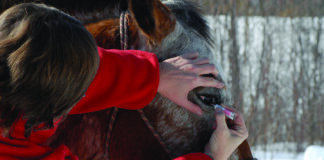

A very well written article. Unfortunately we have just gone through this whole process. Our beautiful boy did not make it as he had multiple lipoma. The only thing I would add to the article is that we were allowed to bring his buddy with him to the hospital. His buddy really helped him have the confidence to get in the trailer, travel to the hospital a and walk into the surgery. His buddy stood by his side while all the tests were being done. Such a stressful time! It would be great to see an article on how to help a paddock mate who is grieving the loss of his friend.